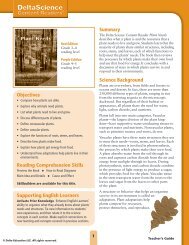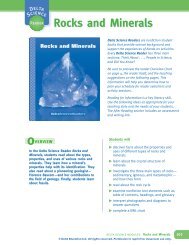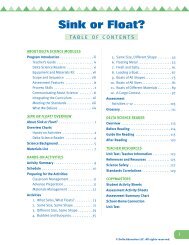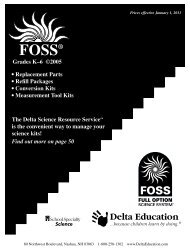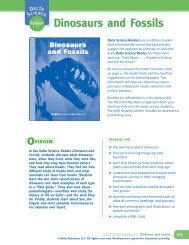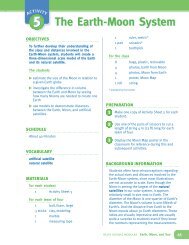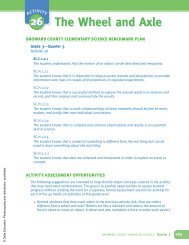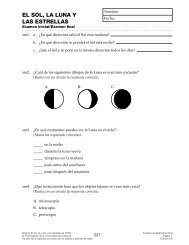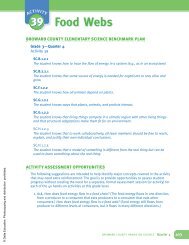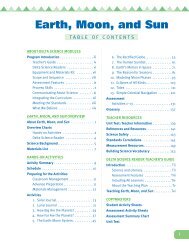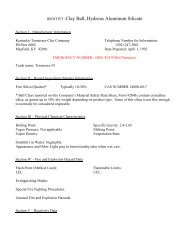Plant and Animal Populations -Teacher's Guide ... - Delta Education
Plant and Animal Populations -Teacher's Guide ... - Delta Education
Plant and Animal Populations -Teacher's Guide ... - Delta Education
You also want an ePaper? Increase the reach of your titles
YUMPU automatically turns print PDFs into web optimized ePapers that Google loves.
Overview Chart for H<strong>and</strong>s-on Activities1H<strong>and</strong>s-on ActivitySeeds or Eggs?page 152 Seeds <strong>and</strong> <strong>Plant</strong>spage 253AField Trippage 354 An Ant Farmpage 435Fruit Fliespage 516 Aphidspage 597Daphniapage 69Student Objectives• examine unidentified brine shrimp eggs• set up an experiment to see if the mystery objects will grow in salt water or in fresh water• observe <strong>and</strong> discuss the growth <strong>and</strong> development of brine shrimp• discuss the differences between plants <strong>and</strong> animals• examine bean seeds closely <strong>and</strong> learn how seeds sprout• examine <strong>and</strong> plant a variety of seeds• compare the growth of different kinds of seedlings <strong>and</strong> plants• review the differences between plants <strong>and</strong> animals• observe, identify, <strong>and</strong> record the numbers of various organisms in a designated area• compare the total numbers of different organisms present in the area (as preparation forthe concept of populations to be introduced later)• examine the anatomy <strong>and</strong> observe the behavior of ants• observe the ants over time as they create a home for themselves in an ant farm• learn about the social life of an ant colony• observe the different stages in the life cycle of fruit flies in their vials• explore the concept of population• note that the fruit fly population increases as the larvae emerge from the eggs <strong>and</strong>metamorphose into pupae <strong>and</strong> then adults• watch the fruit fly population decrease as their food supply runs out• examine the anatomy <strong>and</strong> observe the behavior of aphids• draw conclusions about aphid food preferences• observe <strong>and</strong> record changes in aphid populations over time• examine the anatomy <strong>and</strong> observe the behavior of daphnia• discover that daphnia eat green algae• record changes in daphnia populations over time89Graphing PopulationData page 77PopulationExperimentspage 85• learn about graphs• graph the data they have collected on their fruit fly, aphid, <strong>and</strong> daphnia populations• review the concept of population• examine their team’s daphnia population graphs <strong>and</strong> discuss how the populations arechanging• set up experiments to find out what causes a daphnia population to increase or decrease• observe the results of their experiments <strong>and</strong> draw conclusions• graph the results of their experiments10 L<strong>and</strong> Predatorspage 9511Water Predatorspage 10312 The Changing<strong>Populations</strong> Gamepage 111Assessment page 119• examine the anatomy <strong>and</strong> observe the behavior of ladybugs• predict what ladybugs will eat• observe that the aphid population is reduced by a predator—the ladybug• examine the anatomy <strong>and</strong> observe the behavior of damselfly nymphs• discover another predator-prey relationship, this time in an aquatic environment• predict how a daphnia population will be affected by the introduction of a damselfly nymph• discuss what happens if a predator eats all its prey• act out the roles of aphids, ladybugs, <strong>and</strong> birds in a food chain• discuss the different challenges predators <strong>and</strong> prey must face in nature• discuss how predator <strong>and</strong> prey populations affect each other• See page 119.2 delta science modules© <strong>Delta</strong> <strong>Education</strong> LLC. All rights reserved.
<strong>Plant</strong> <strong>and</strong> <strong>Animal</strong> <strong>Populations</strong>Process Skillsobserve, predict, experiment,communicateVocabularybrine shrimp, egg, fresh water, predict, salt water, seed<strong>Delta</strong> ScienceReaderpages 2–3, 8–9observe; compare; measure;collect, record, display, orinterpret datacollect, record, display, orinterpret data; classifyseed coat, seedling, sproutorganismpages 4–5pages 2–3,8–9, 14observe, use numbers, inferabdomen, ant, antenna(e), colony, head, insect, m<strong>and</strong>ible,thoraxpages 6–7observe; define based onobservations; use numbers;collect, record, display, orinterpret datafruit fly, larva(e), life cycle, population, pupa(e)pages 6–7observe; infer; collect, record,display, or interpret dataaphid, exoskeleton, molt, reproducepages 6–7observe; infer; collect, record,display, or interpret dataalgae, daphnia, digestive tract pages 6–7, 8–9collect, record, display, orinterpret datagraph pages 8–9, 15hypothesize, experiment, usevariables, infercontrol, experimental setup, variablepages 14, 15observe; predict; collect, record,display, or interpret data; inferladybug, predator, preypages 10–11,12–13observe; predict; collect, record,display, or interpret data; inferdamselfly nymphpages 10–11,12–13make <strong>and</strong> use models,communicate, inferpages 14, 15See the following page for the <strong>Delta</strong>Science Reader Overview Chart.<strong>Plant</strong> <strong>and</strong> <strong>Animal</strong> <strong>Populations</strong> 3© <strong>Delta</strong> <strong>Education</strong> LLC. All rights reserved.
Overview Chart for <strong>Delta</strong> Science Reader<strong>Plant</strong> <strong>and</strong> <strong>Animal</strong> <strong>Populations</strong>SelectionsThink About...What Is a Population?page 2What Do <strong>Plant</strong>s Need?page 4What Do <strong>Animal</strong>s Need?page 6What Is an Ecosystem?page 8What Are Predators <strong>and</strong> Prey?page 10What Is a Food Chain?page 12Vocabularyhabitat, living, organism, population, speciesadaptations, nutrientscommunity, ecosystem, interact, nonlivingcamouflage, mimicry, predator, preycarnivore, consumer, decomposer, energy,food chain, herbivore, omnivore, producerRelatedActivityActivities 1, 3Activity 2Activities 4, 5,6, 7Activities 1, 3,7, 8Activities 10, 11Activities 10, 11,12People in Science• Park Naturalistspage 14Activities 3, 9Did You Know?• About Endangered Speciespage 15endangered, extinctActivities 8, 9,12See pages 127–135 for teaching suggestionsfor the <strong>Delta</strong> Science Reader.4 delta science modules© <strong>Delta</strong> <strong>Education</strong> LLC. All rights reserved.
MATERIALS LIST<strong>Plant</strong> <strong>and</strong> <strong>Animal</strong> <strong>Populations</strong>Quantity Description Quantity Description1. . . . . . . . . ant farm1. . . . . . . . . baster1. . . . . . . . . brine shrimp eggs, vial*1. . . . . . . . . chart, Aphid Population Data*1. . . . . . . . . chart, Changing <strong>Populations</strong>Game*1. . . . . . . . . chart, Daphnia PopulationData*1. . . . . . . . . chart, Fruit Fly PopulationData*1. . . . . . . . . chart, How Many Organisms?*1. . . . . . . . . chart, <strong>Plant</strong> or <strong>Animal</strong>?*3. . . . . . . . . charts, Population Data Graph*32. . . . . . . . . containers, 10-oz50. . . . . . . . . cups, foam32. . . . . . . . . cups, plastic, 1-oz16. . . . . . . . . daphnia counters16. . . . . . . . . droppers1. . . . . . . . . index cards, p/100*32. . . . . . . . . lids, with holes, for 10-ozcontainers16. . . . . . . . . magnifiers1. . . . . . . . . pipe cleaners, p/36*50. . . . . . . . . planter sticks1. . . . . . . . . salt, non-iodized, 1 lb*2. . . . . . . . . seeds, clover, 25 g*2. . . . . . . . . seeds, fava bean, p/100*1. . . . . . . . . seeds, grass, p/1,000*1. . . . . . . . . seeds, pea, p/2,000*4. . . . . . . . . soil, potting, 4 qt*1. . . . . . . . . tape, masking*1. . . . . . . . . transparency, Ant1. . . . . . . . . transparency, Aphid1. . . . . . . . . transparency, Damselfly Nymph1. . . . . . . . . transparency, Daphnia1. . . . . . . . . transparency, Fruit Fly LifeCycle1. . . . . . . . . transparency, Ladybug8. . . . . . . . . trays, plastic16. . . . . . . . . vial holders32. . . . . . . . . vials, with caps1. . . . . . . . . yarn, red, skein1. . . . . . . . . Teacher’s <strong>Guide</strong>8. . . . . . . . . <strong>Delta</strong> Science Readers1. . . . . . . . . Living Material Card 1*Shipment includes:1 jar algae100 aphids200 daphniadaphnia water8 vials fruit flies1. . . . . . . . . Living Material Card 2*Shipment includes:16 damselfly nymphs200 daphniadaphnia water32 ladybugs1. . . . . . . . . Living Material Card 3*Shipment includes:1 vial antsTEACHER-PROVIDED ITEMS18. . . . . . . . . bags, paper16. . . . . . . . . bags, plastic, reclosable, 1-gal2. . . . . . . . . bowls, large33. . . . . . . . . c<strong>and</strong>ies, chocolate33. . . . . . . . . cashews, whole4. . . . . . . . . containers, 1-L–. . . . . . . . . crayons1. . . . . . . . . hole punch17. . . . . . . . . markers, felt-tip–. . . . . . . . . newspaper1. . . . . . . . . overhead projector330. . . . . . . . . paper clips, small–. . . . . . . . . paper towels33. . . . . . . . . pasta, shell33. . . . . . . . . peanuts, in shell11. . . . . . . . . pen caps32. . . . . . . . . pencils1. . . . . . . . . popcorn, unpopped, bag33. . . . . . . . . raisins, seedless88. . . . . . . . . rubber b<strong>and</strong>s8. . . . . . . . . rulers, metric8. . . . . . . . . scissors10. . . . . . . . . spoons, large2. . . . . . . . . spoons, measuring–. . . . . . . . . sugar33. . . . . . . . . sunflower seeds, in shell–. . . . . . . . . water, spring–. . . . . . . . . water, tap* = consumable item † = in separate boxTo order consumable items or refill kits, please call 1-800-442-5444.<strong>Plant</strong> <strong>and</strong> <strong>Animal</strong> <strong>Populations</strong> 7© <strong>Delta</strong> <strong>Education</strong> LLC. All rights reserved.



